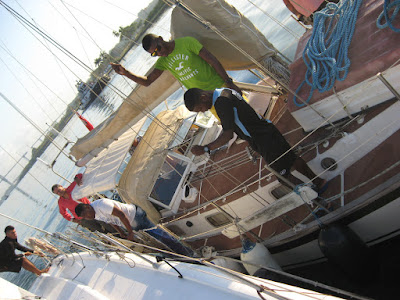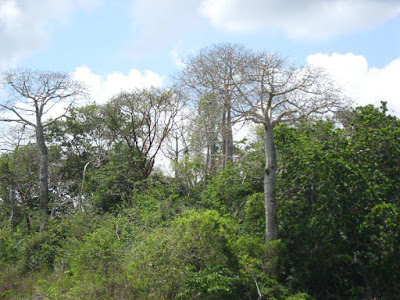 Jason and I agreed to be line handlers for a catamaran that was heading through the Canal on their way to French Polynesia. The owners were a French couple who planned to stay there for a long time, so the late start across the Pacific Ocean wasn't so much of a concern to them. Here, Jason and Karen relax on the beanbags on Oviri, the boat we took through the Panama Canal.
Jason and I agreed to be line handlers for a catamaran that was heading through the Canal on their way to French Polynesia. The owners were a French couple who planned to stay there for a long time, so the late start across the Pacific Ocean wasn't so much of a concern to them. Here, Jason and Karen relax on the beanbags on Oviri, the boat we took through the Panama Canal.Our first night out, Nathalie fixed us beef bourguignon and gnocchi for dinner with a nice wine.
Jean-Luc and Juan after our meal and dessert.
We motored under the new bridge under construction over the Bay of Colon as we headed for the first set of locks early the next morning.
Nathalie fixed us coffee and sandwiches for breakfast nibbles.
The shipping never stops in Colon and the Canal.
Sunrise as we approach the first locks.
Going under the new bridge.
The two spans are almost ready to meet in the middle. Plenty of room for ships to pass under this bridge.
Jason on our early start for the locks.
The monohull that rafted to our starboard side. We actually knew this yacht from our time in Deltaville, VA. The blue lines are the ones rented for use on Canal transits.The monohull on our port side, getting rafted up for the transit.
A big tug used to push the barges and ships around.
The men on the wall are waiting to throw us lines attached to monkeyfists so we can tie our blue lines to them. Then the men will pull the lines to the wall to tie them off.
We shared the lock with this Panamax car carrier. Pay attention to the letter 'G' in the name. In the next shot, you'll see a man standing above it to give you some idea of how huge these ships really are.
The man looks tiny on the stern of this huge Korean car carrier.
This man has thrown the monkeyfist and is pulling the line from the yacht up to tie it off on the bollard there.
They let the lines down once we are done in the first lock, but hold onto the lines and walk along the wall with the progress of the boats into the next lock area, where they will pull the line up again and tie us off for the next raising of the water level. The water goes up about 31 feet, raising the boats with it.
The water still tries to flow as the lock gates close.
The water level is all the way up now, and the ship starts its engines and engages the propeller to move out of the lock. You can see the turbulence now created by the prop on the ship.
We wait until the turbulence is out of the way before we follow the Panamax vessel out of the locks.
One of the tugs zips past us on Lake Gatun. They create quite a wake behind them and we had to turn into the waves they created to avoid rocking the boat hard. They zoom around regardless and yachts must take evasive action.
Another Panamax car carrier from Korea passes us going the other way across Lake Gatun. We saw several of these during our transit, so Korean cars must be getting very popular.A blooming jacaranda with the purple flowers on the shores of Lake Gatun.
It's jungle foliage on the shores, with very few mud beaches. Our advisors aboard claim they've seen large jungle cats and alligators on some transits.
Alligators love to hide in holes in shores like these.

The only signs of any inhabitants on Lake Gatun. We thought they might be the tenders of the radio towers there. We saw only a few small power boats on the lake as they don't want people living here. Lake Gatun is the major supply of water for the country.
A fully laden ship passes us going the opposite direction across the lake.
Seventeen containers wide mean this container ship is one of the Super-Panamax carriers. It will have to use the new set of locks as it is too big to use the locks we came through, bigger than those Panamax car carriers we saw.
Some trees along the shores looked almost like the baobab trees we saw in Madagascar, with the fat trunks and all the branches at the top, like an upside down tree.
This big four-masted boat motors tourists around and rarely hoists its sails.
They are still clearing land along the edges of the canal in some parts.
The tug train moves in front of us as it turns the barge.
A Panamax carrier tied off on the side of the Canal below the Centennario Bridge. Sometimes the traffic is held up as the lock lanes are being used for vessels coming the other direction.
Passing under the bridge.
The tourist ferry with passengers from a cruise ship that passed us in the new set of locks early in the morning. The ferry was once owned by Al Capone.
Jean-Luc with his sun protection hat on.
Jason and Karen relaxing in the bean bags on the front of Oviri.
We rafted up to the ferry to go through the second set of locks. The ferry tied directly to the wall so they only needed their two line handlers to let out slack as we dropped down in elevation with the water.
The tour operator on the ferry is talking to Jason about our cruising experiences and our circumnavigation. He then got on his microphone and told all the ferry passengers about us and our adventures. There were lots of friendly folks who wanted to chat while we transited the locks.
The locks are 100 years old and they leak a bit.
At the Mira Flores Lock, tourists cram the several levels of the visitor center to see ships come through the last of the locks into the Pacific Ocean. We waved at each other and I'm sure we're in some stranger's vacation pictures.
Nathalie taking pictures on the transit. It was her first time through the Panama Canal.
We untied from the ferry and backed off to let them go first out of the lock.
A ship sideways under the Bridge of the Americas at the end of the Canal transit. The ship is backing out of a loading berth where the cranes are and then it turned and headed away.
A glimpse of the skyline of Panama City as we headed away from the locks and down the coast of Panama along the Pacific coast.
The Albrook Mall is a huge mall in Panama City where we went to get fresh produce for Oviri's departure. These giraffe statues were inside the mall lane.
Looking down at the carousel from the second level of the food court in the mall.
These orchids were growing on Oviri. Such pretty blossoms.
We took a mooring at the Balboa Yacht Club until we left. It's a rolly, noisy place to anchor or moor because the service launches and tugs for the ships transiting the canal zip in and out of here. These six rafted near us; one or more was almost always running and they came and went at all hours.
A sunset looking from our mooring at Balboa Yacht Club.
Jean-Luc made us caipirinhas to celebrate our completion of the transit. It's a rum drink with mint and lime and sugar, very popular in Brazil. Tasty.
Jason and I moved to a hotel in Panama City for a few days before we returned to the States. On a walk around, we passed this ornate church. I really liked the spires on it.
Jason talking with Gail, a fellow cruiser we met as we started our cruising in the San Blas Islands of Panama.
Jason, Barry, and Gail stop in the Albrook Mall to view an art sculpture.
We had one more day in Panama City and then flew to Denver. The adventure was over for now.


























































No comments:
Post a Comment